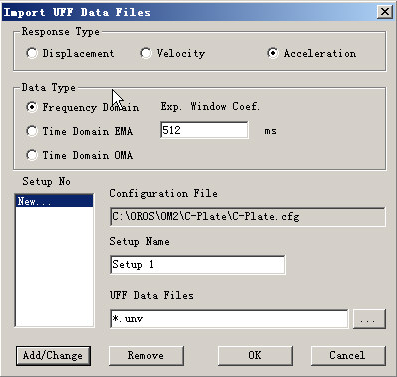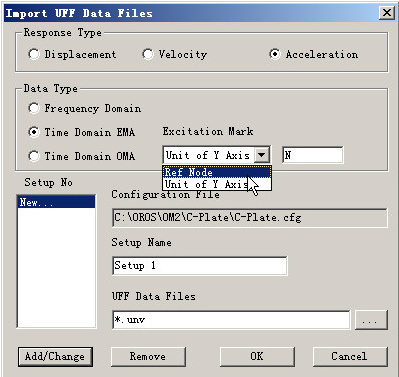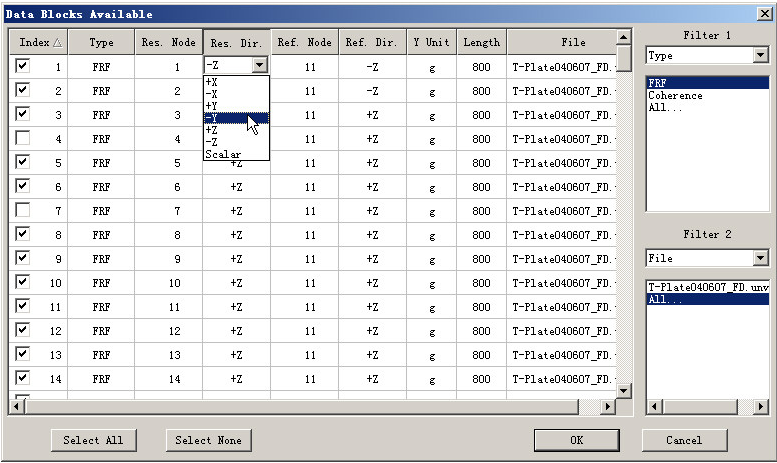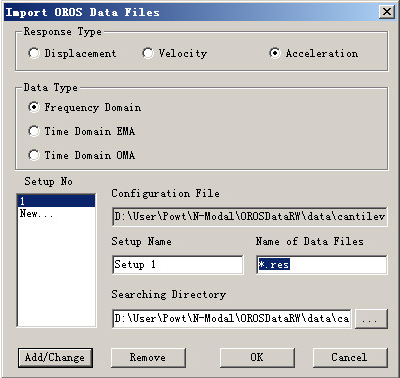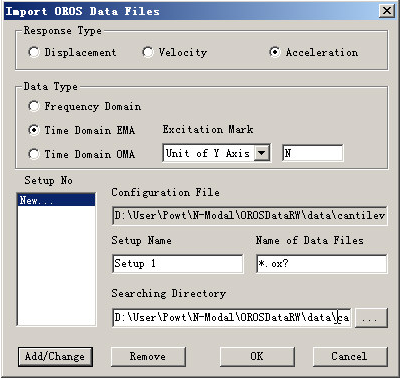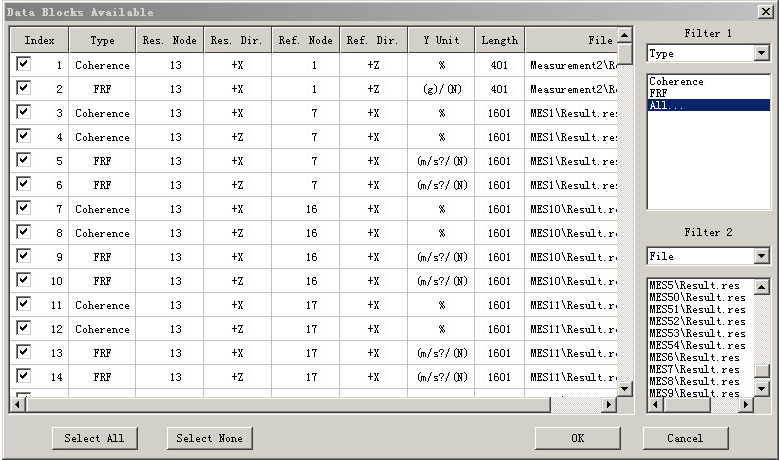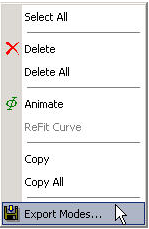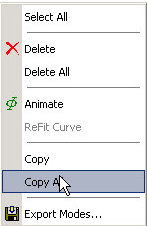Difference between revisions of "Modal Import Export"
| Line 1: | Line 1: | ||
[[category:Modal]] | |||
==Import / Export== | ==Import / Export== | ||
Revision as of 09:54, 10 September 2020
Import / Export
Data and all kinds of results can be exported or printed, which provides you great convenience to write a report or give a presentation. These functions include: Importing data, exporting data, m exporting table,export graphics, exporting animations, print preview and print].
Import
Geometry
You can import geometry information from UFF 15/82/2412 files and IGES files
Data Files
UFF
You can import measurement data in frequency domain (including Frequency Response Functions and Coherence Functions) or time domain (time histories) from the UFF 58/58b files.
- Response Type
The type of response to be imported. Generally we use accelerometers, so we specify the type as "Acceleration" here.
- Data Type
The type of data to be imported. There are three types here: 1) frequency response functions (and coherence functions) for EMA analysis, 2) time histories for EMA analysis, and 3) time histories for OMA analysis.
If FRFs which have been applied with exponential windows are to be imported, you need fill the content of "Exp. Window Coef." to modify the increasing damping caused by the exponential window.
If time histories are to be imported, you need specify the marker to distinguish excitation signal from response signal. Here you have two options: reference DOF (REFDOF) or the unit of Y Axis. When the marker is REFDOF, the measurement information of excitation signal should be defined in the field the reference node and direction. While the marker is the unit of Y Axis, software take the signal block with the unit you specified as excitation signal.
- Setup Name and UFF Data Files
Then you can specify or modify the "Setup Name" and "UFF data files" for each setup. The wildcards (’*’ or ’?’) is allowed to refer to multiple UFF files. If many files are included, you are recommended to use wildcards manually. The common definition of wildcards is employed: "*" to represent any multiple characters, and ’?’ to represent a single character. For example, the "*.unv" represents all the files whose extension names are "unv" in the same directory of this configuration file.
Note (very important): if you want to import time domain UFF data files for EMA, you’d better use the wildcard. You must put the measurement data of one test (for example, in the IMRT, one test means the measurement of one point) into one UFF file. If you have 20 nodes to measure in an IMRT, then you should have 20 UFF files, such as node01.uff, node02.uff, ... node20.uff. Here you can use "node*.uff" to import all the 20 files.
- Buttons
Press the "Add/Change" button to confirm this operation, then these data files information will be stored for the specified setup. For an EMA test, you are only allowed to have one setup, no matter whether it is time domain or frequency domain. For an OMA test, you are allowed to add more setups.
Press the "OK" button to write these information to the current configuration file, and the new configuration file will be automatically reloaded to import the data specified.
The following interface will appear after the importing:
You can check or change the information of imported data here, such as the response nodes and directions. You can also unselect the data you don’t like. Click the header of each column, the current list will be sorted. In the right of this dialog, two filters are set for convenience.
OROS Format
You can import measurement data in frequency domain ("*.res", including Frequency Response Functions and Coherence Functions) or time domain ("*.oxf" or "*.oxl", time histories) from the OROS format data files.
The interface for importing OROS format data files is very similar with the one for importing UFF data.
To import the FRFs and COHs from the OROS ".res" files, you don’t need to specify the the "Exp. Window Coef." . Because this information is included in the ".res" file, and will be read by OM2 automatically.
The data files of one modal test may be stored in many different directories, so in this interface you should specify the "Searching Directory", but not the name of files. OM2 will search data files in the specified directory and all its subdirectories.
The same interface which allows you to check and change the information of imported data will appear after the configuration file is reloaded.
Equations
You can import the constrain equations from a ASCII format configuration file. The imported equations will be appended to the current equations list in the project. Please note that the sequence of equations is very important, which might lead to different animation effect.
Modes
You can import identified modes (including frequencies, damps, mode shapes, modal A and modal B) from UFF 55 files. An item called "Imported" will appear in the branch of "Data\Setup?\Mode" in the "Data" page of "Workspace" Panel.
Export
Data and all kinds of results can be exported or printed, which provides you great convenience to write a report or give a presentation.
Data
You can export the modes by corresponding toolbar of the mode list view ![]() or the right click menu.
or the right click menu.
All the mode can be exported to a UFF 55 file (".unv") or ASCII file (".asc").
Data such as input signals, output signal, frequency response functions, power spectrums, and coherences can be exported to UFF files or ASCII files in the "Data" tab page of Workspace shortcut panel.
All the data in the data table view can be exported to an ASCII file.
Table
The identified mode list can be export to Microsoft WORD as an table by the following steps:
- Copy the Mode List to Clipboard
’Copy’ button ![]() in the standard toolbar or ’Copy All’ item in the right click menu of the mode list view can be used to copy all the modes to system’s clipboard. If only part of the modes are needed, please select the items you wanted by ’Shift’ or ’Ctrl’ keys (just like the operations in the Windows’ Explorer), then click on the ’Copy’ item in the right click menu.
in the standard toolbar or ’Copy All’ item in the right click menu of the mode list view can be used to copy all the modes to system’s clipboard. If only part of the modes are needed, please select the items you wanted by ’Shift’ or ’Ctrl’ keys (just like the operations in the Windows’ Explorer), then click on the ’Copy’ item in the right click menu.
- Paste to WORD and Create the Table
Run WORD and create a new document, and paste the contents in the clipboard into it. Select the pasted lines, and use the Insert Table Command, the a new table containing the modes are created. To prettify this table, you can adjust it furthermore.
If you want to use these tables in Microsoft PowerPoint, you can create the table in WORD first, and then copy it to the PowerPoint.
Graphics
Everything in the main window, including the 2D curves, 3D graphics, data tables and so on, can be captured and saved as BMP or JPG graphic files by the ’Save Snapshot’ button ![]() in the standard toolbar.
in the standard toolbar.
You can also copy a snap into Windows’ clipboard by the ’Copy’ button ![]() in the standard toolbar, and then paste it to the document.
in the standard toolbar, and then paste it to the document.
Animations
The animations of mode shapes or ODS in Modal can be saved as AVI media files according to the following steps:
- Make sure that the mode shape or ODS wanted is shown in activated.
- Press the "Record" button
 in the "3D Display" shortcut panel (or using the right click menu), and enter the wanted file name. The default name can be changed from the dialog of "Set Properties...".
in the "3D Display" shortcut panel (or using the right click menu), and enter the wanted file name. The default name can be changed from the dialog of "Set Properties...". - Saving progress will be displayed in the status bar. You can play this AVI file with some media player, or insert it to the WORD/PowerPoint documents.
- The AVI file is encoded with the CODEC you set in the dialog of " Set Properties...". Some CODECs might fail to work correctly. If this happens, please select another one in the dialog of "Set Properties..."..
- Different CODEC leads to different play quality and different file size, you can select the best after trying all.
Everything displayed in the main window, including the 2D curves, 3D graphics, configuration information, data tables and so on, can be previewed by ![]() button or printed by
button or printed by ![]() button in the standard toolbar. Of course, you can realize these operations by menu too.
button in the standard toolbar. Of course, you can realize these operations by menu too.
